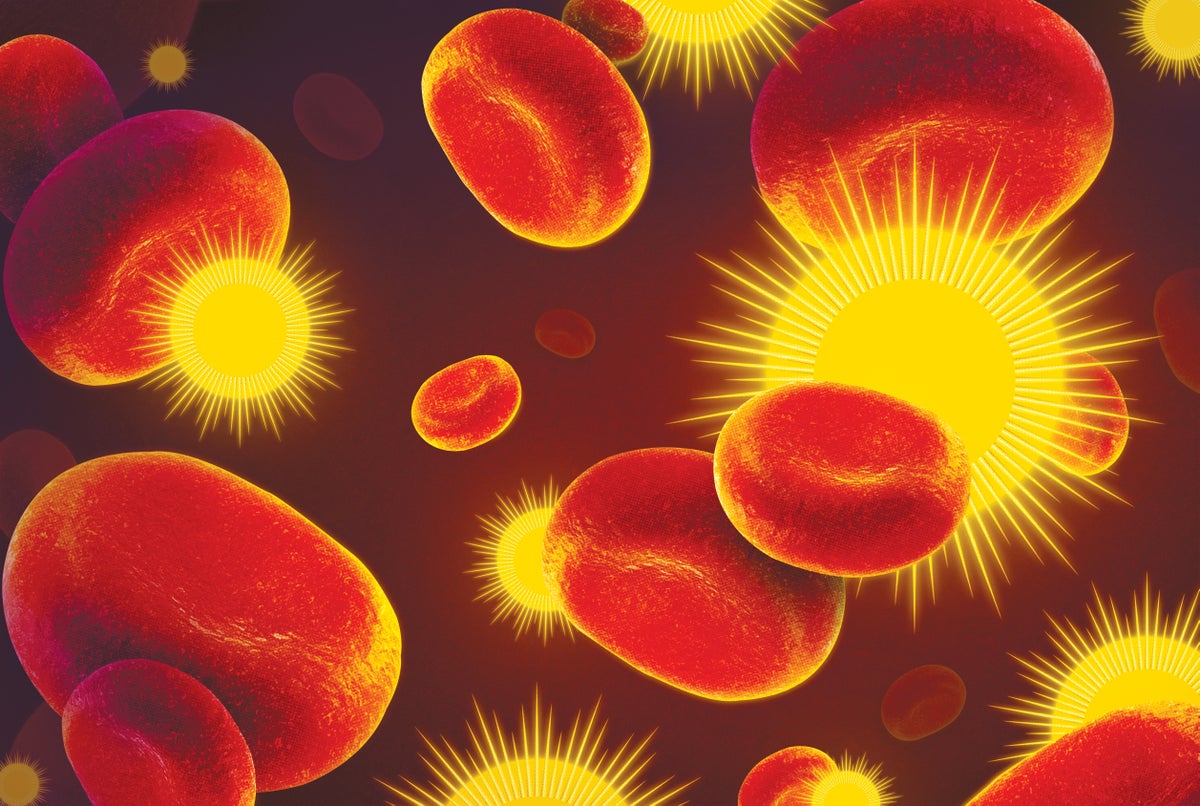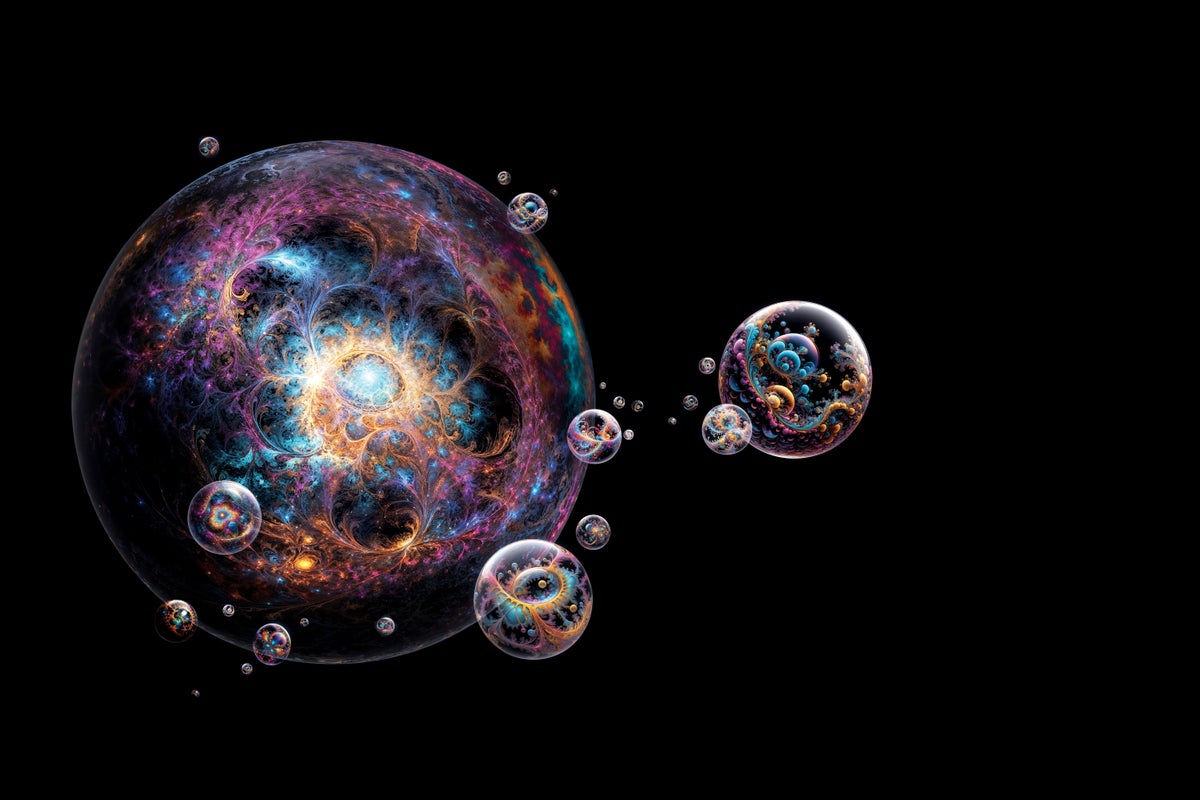Now Reading: The Universe’s First Light Could Reveal Secrets of the Cosmic Dawn
-
01
The Universe’s First Light Could Reveal Secrets of the Cosmic Dawn
The Universe’s First Light Could Reveal Secrets of the Cosmic Dawn
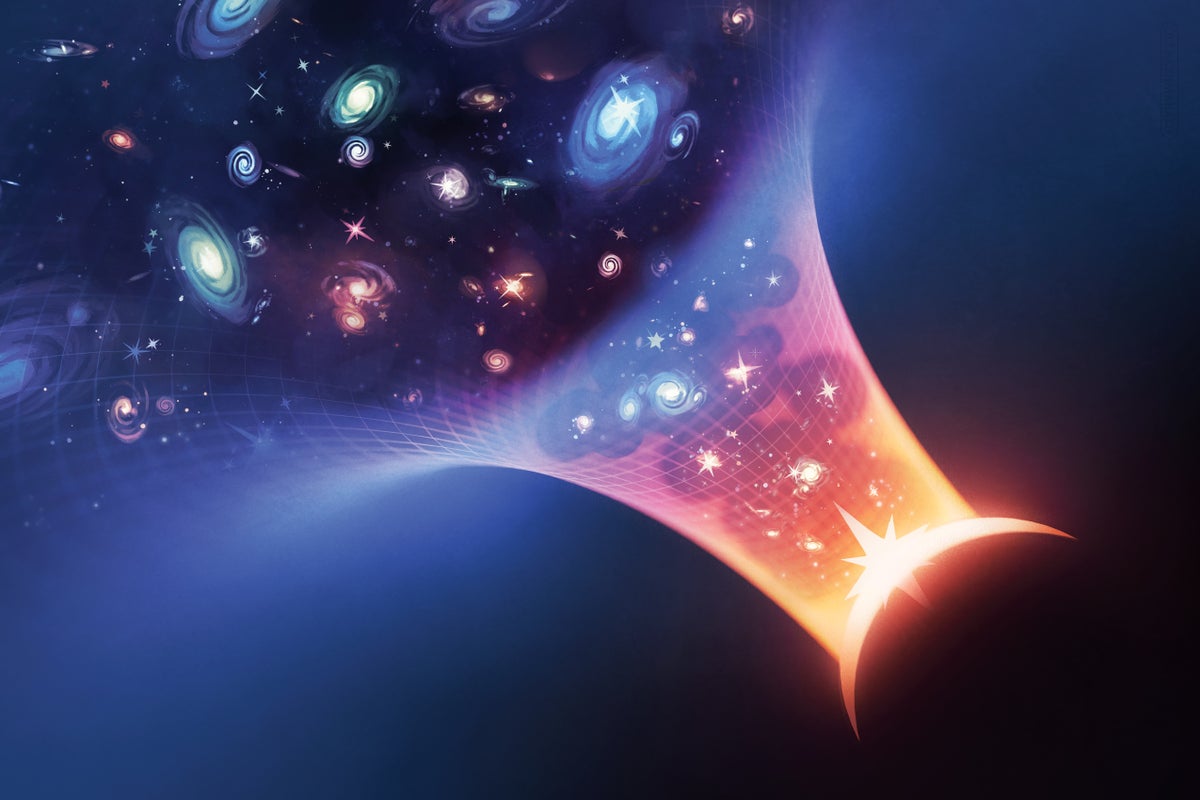
On what might have been the proudest day of Jack Burns’s long career in astronomy, he was sitting on a beach. Orbital dynamics and launch schedules wait for no one, and Burns couldn’t move his long-planned family trip. So in February 2024, while on vacation in Maui celebrating his successful cancer treatment the prior year, Burns listened to a live feed from the mission control of private aerospace company Intuitive Machines. The firm’s Odysseus lander was about to become the first commercial spacecraft to touch down on the moon.
It was carrying an instrument for a project Burns had helped design: an array of four antennas designed to listen for radio waves at the lunar surface—a first small step toward tuning in to the earliest days of the universe. As Burns listened, Odysseus landed on the moon’s surface—and then tipped over. Burns’s instrument, the Radio wave Observation at the Lunar Surface of the photoElectron Sheath (ROLSES) experiment, captured data for 25 minutes. “It was still functional enough for us to deploy our antennas and get some data, so we can declare that the epoch of radio astronomy on the moon has begun,” Burns recalled during a video chat, pumping his fists in the air. “My students say, ‘Oh, this is disappointing,’ and I say, ‘You’re right, but look at it from my perspective. Look how long it’s taken us to get there.’”
The short-lived experiment was a career highlight for Burns, now a professor emeritus at the University of Colorado Boulder, and it was a boon for a new generation of radio-astronomy cosmologists now taking the lead. Analyzing those few minutes’ worth of data could help scientists eventually design a full lunar radio observatory. Such a mission could let researchers peer through all the light there is, all the way back to the universe’s very first light, to the time before galaxies or stars, before even the first molecules—to a phase called the dark ages, when there was nothing but electrons spinning around atoms of hydrogen.
On supporting science journalism
If you’re enjoying this article, consider supporting our award-winning journalism by subscribing. By purchasing a subscription you are helping to ensure the future of impactful stories about the discoveries and ideas shaping our world today.
The end of the cosmic dark ages and the start of cosmic dawn mark the time when the universe as we know it began to take shape. We can’t see back to this cosmic era. But by detecting faint, long-wavelength radiation from the wriggling atoms of this epoch, we may be able to develop a more detailed picture of why our universe looks the way it does today and how it got that way.
ROLSES was among the first forays into this new frontier. A NASA-funded project called the Lunar Surface Electromagnetics Experiment, which is set to land on the moon in 2026 onboard a different commercial lunar lander, will also conduct low-frequency radio astronomy to investigate these questions. These two missions will join a dozen others based in Earth’s most austere reaches, all aimed at studying this lightless era of the universe, the cosmic dark ages, and the ushering in of the cosmic dawn.
“From the time before there even are galaxies, the blunt answer is that currently we can do almost nothing,” says Sarah Bosman, an early-career researcher studying the cosmic dawn, who leads a team at the University of Heidelberg in Germany. But that all stands to change with the new generation of experiments starting up. “There is an enormous amount of money going into observatories to see this; we have talked about this for 50 years now.”
Everything started in the tremendous burst of energy known as the big bang. Within a few seconds the universe cooled enough for the first protons, neutrons, electrons and photons to spark into existence, and within a few minutes those building blocks came together to form the first nuclei of hydrogen and helium. After about 380,000 years, the universe was sufficiently cool for those protons and neutrons to grab free-flying electrons and form the first electrically neutral atoms. For the first time, photons stopped colliding with free electrons and were able to flow through the universe. This process, confusingly called recombination—it was actually the first true combination of atomic components—released the cosmic microwave background (CMB) light that pervades all of space. The most detailed map of this background is from the Planck satellite, a European space observatory that launched in 2009 to study this light.
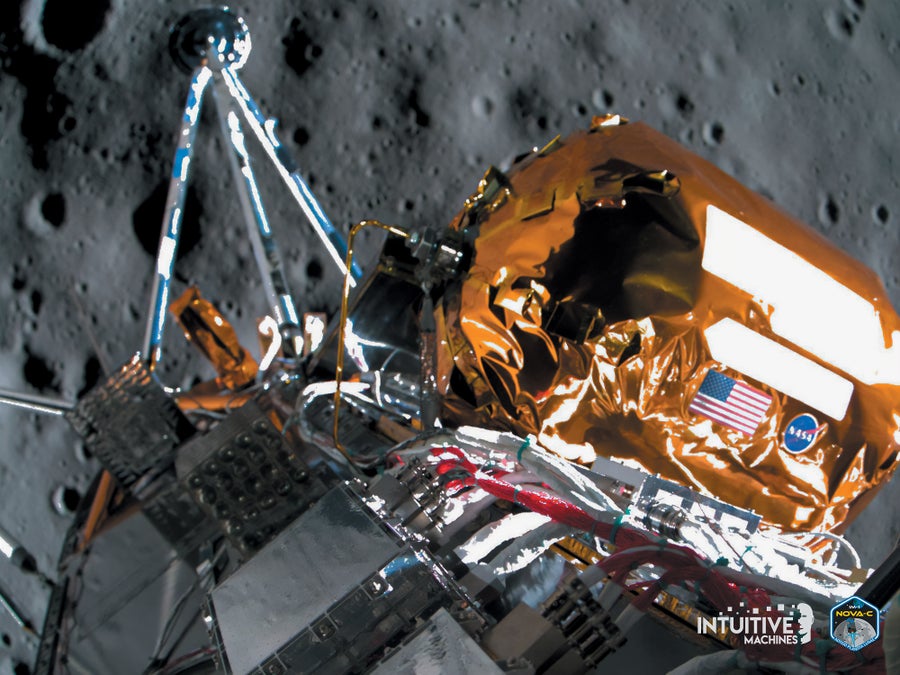
Intuitive Machines’s Odysseus lander took this snapshot of the moon as it descended toward the surface.
Intuitive Machines
In the glow of the CMB, the universe kept filling with neutral atoms. With no stars to shine through the gas, darkness persisted for the next 50 million years. Hydrogen atoms absorbed all photons that remained from the big bang, shrouding the universe in fog. Dark matter invisibly clumped together during these cosmic dark ages, and gravity quietly shepherded matter to form the superstructure of the universe. While gravity was at work, random fluctuations in the density of matter were already charting the universe’s course.
Sometime between 50 million and 100 million years ago, gravity drew hydrogen atoms together and ignited the first stars. Their sparkling ultraviolet light recharged the neutral gas, kicking electrons out of atoms and giving the atomic nuclei positive charges. This end to the dark ages marked the beginning of the cosmic dawn—another era we are just now able to study.
At some point during the dawn, the first stars shone brightly enough to prevent hydrogen nuclei from recombining with electrons into neutral atoms, ending the dark ages for good. This change is called the epoch of reionization, and it is when the universe became transparent to light again. Eventually during this period—we don’t know exactly when or how it happened—gravity swept the first stars into the first galaxies and galaxy clusters. Now the light from those earliest galaxies is seeping into the infrared instruments of the James Webb Space Telescope (JWST), surprising everyone by showing that the early universe was dramatically brighter than anyone expected. Those early, bright objects might shine some figurative light on the epoch of reionization itself.
“With Planck data, we have this picture of the densities of the universe 380,000 years after the big bang. And we have a picture later of all the galaxies from the Sloan Digital Sky Survey, the Dark Energy Survey, James Webb, and other stuff. But we don’t have anything between them,” says Charlotte Mason, an astrophysicist at the University of Copenhagen.
The origin of the cosmos is a story we can unravel through gravity and particle physics, but what we are missing, and need to understand, is how the first starlight changed the course of the entire universe.
Scientists have so many open questions. Did galaxies churn out stars in furious bursts? Was there a period of “disco reionization” when the universe pulsed bright and then dark again in a continual pattern? Did reionization happen just once or maybe twice? Did it happen on a local scale in certain cosmic regions, or did everything light up everywhere all at once?
“There is so much that we don’t know about galaxy formation,” says Sangeeta Malhotra, an astrophysicist at the NASA Goddard Space Flight Center. “My motto as an observer is that everything that can happen that is permitted to happen will happen.”
Because of the accelerating expansion of the universe, astronomers can infer that objects at great distances are very far back in time. The stretching of their light into longer wavelengths, known as redshift, tells us their ages.
But when scientists peer very far back, they find conundrums. JWST observations of the distant past are at odds with theoretical physics in many ways. One surprising discrepancy involves the timeline of the cosmic dark ages, the epoch of reionization and the cosmic dawn.
In 2022 Bosman and her colleagues used 67 quasars (galaxies with bright, supermassive black holes at their centers) to determine that the cosmic dawn ended—that is, reionization was complete—1.1 billion years after the big bang, 200 million years later than previously thought. The timing of this event had been a controversy for more than two decades. But then JWST came on the scene. According to JWST observations from May 2024, ultrabright, huge galaxies were blazing brilliantly 750 million years before the end of the cosmic dawn. If they were shining brightly enough to reionize all the neutral gas, why did that process—reionization—take as long as it apparently did?
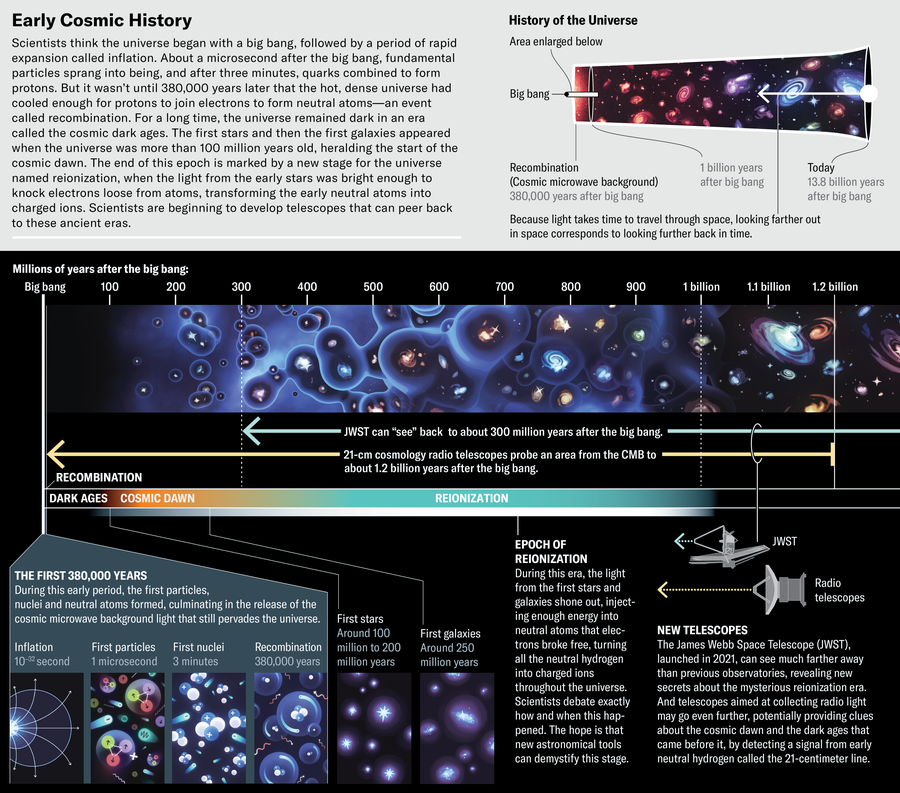
Olena Shmahalo and Jen Christiansen; Source: Nivedita Mahesh (scientific reviewer)
The current record holder for the oldest known galaxy is a mammoth object found at a redshift of 14.18, which means we see it as it appeared just 300 million years after the big bang. The galaxy is called JADES-GS-z14-0, named for the JWST search program that found it. When this galaxy first shone forth, the universe was just 2 percent of its current age, and the end of reionization was still hundreds of millions of years in the future.
“These bright galaxies should have been able to finish reionization earlier than they did,” Bosman says. Researchers are now unsure which is off: our measurements of stellar brightness or our theories. If it’s the latter, new models will be necessary to explain the ultrabright galaxies. The next few years of JWST data releases are likely to raise even more questions.
Some astrophysicists argue that a small number of incredibly luminous galaxies could have reionized the gas, letting light shine through the universe. Or it could have been the work of multitudes of faint galaxies that we can’t see now and maybe never will, says Jackie Champagne, a postdoctoral researcher at the University of Arizona who studies the epoch of reionization. The projects aiming to investigate the cosmic dark ages and cosmic dawn will try to find the oldest, earliest objects that put light into the universe.
“As we get closer to seeing cosmic dawn, we should be seeing smaller galaxies, fainter galaxies, and fewer of them,” Champagne says. “We should be reaching the limit where there just are no more galaxies to see.”
Studies of galaxies are one way to answer questions about the first light in the universe. Another is to study what was there before the galaxies formed: the neutral hydrogen gas before it was reionized. Because this ancient atomic hydrogen existed during the dark ages, we can’t see it directly. But there are ways to map its presence.
Malhotra has been studying galaxies that emit light in a certain wavelength that is characteristic of the recombination of hydrogen—the moment when neutral atoms formed. This wavelength is visible in a galaxy’s light spectrum in the form of a bump called the Lyman-alpha spectral line (the galaxies are called Lyman-alpha emitters). Surveys of these objects can help astronomers build a map of the cosmic dawn, but that requires studying a large patch of sky in the right wavelengths of light, Malhotra says. NASA’s Nancy Grace Roman Space Telescope, planned to launch in May 2027, should finally deliver this information. “It’s beautiful,” Malhotra says. “With Roman, we are really looking forward to great science.”
Meanwhile 10 experiments being planned on Earth and at least two designed for the moon will also attempt to study the time of darkness. These experiments must be set up in austere environments, such as on a floating platform in the middle of a lake, in the Arctic or on the moon, where FM radio signals can’t interfere with observations.
Cynthia Chiang, an experimental cosmologist at McGill, works on small observatories—roughly the size of a dining room table—that can listen to the faint universe. In her current project, Chiang deploys these antennas in the high Canadian Arctic, which is free of broadcast signals and other radio pollution. Whereas radio telescopes such as the Very Large Array and the Square Kilometer Array are built to produce images, Chiang’s work is more like a car radio tuner that can scan all stations at once. ROLSES had similar aims, and studying the moon’s environment in radio frequencies can help astronomers determine how natural and human-generated activity could interfere with later, more sensitive operations. The experiments will help unveil some of the early history of the universe, Chiang says.
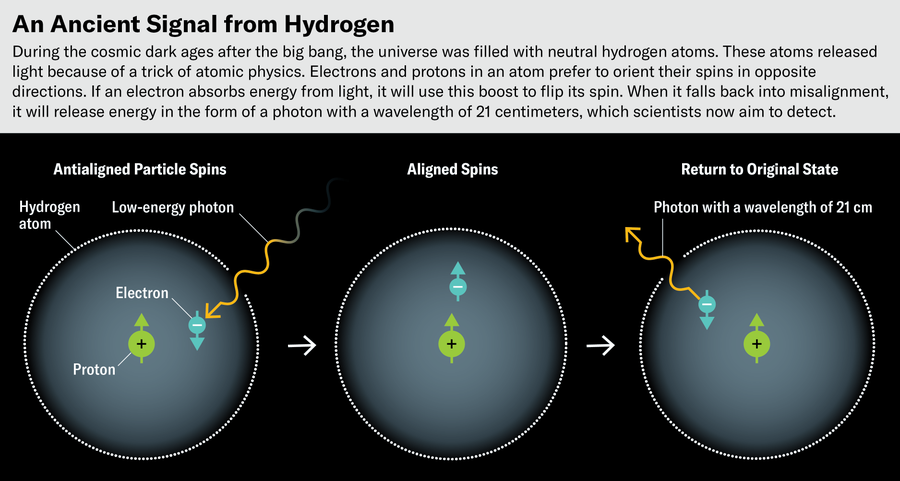
Jen Christiansen
“If you think about it in terms of a human lifetime, the period of the first stars corresponds to the age of a toddler,” Chiang says. Although humans change slightly in appearance as we grow, in early childhood many of us already resembled the adults we would eventually become. In a similar way, astronomers can use early cosmic history to make inferences about how the universe came to be its present-day self, Chiang says.
But looking for toddler pictures of the universe is akin to looking for a candle flame inside the sun. The information is outshone by everything else. To see it, the latest generation of dark ages astronomy experiments are relying on a trick of atomic physics.
When the universe was full of neutral hydrogen, it was opaque because the atoms couldn’t interact with photons. The hydrogen could simply float through space, but photons from the big bang were essentially trapped among them. Yet there was still light we can perceive because hydrogen atoms naturally glow on their own. An atom’s spinning electron slightly prefers to orient itself perpendicular to the nucleus’s spinning proton. If those alignments flip, the energy in the atom changes slightly, and the atom will eject that energy by emitting a photon with a wavelength of 21 centimeters. Astronomers try to glimpse this transition by searching for radio signals that correspond to that 21-cm-long light wave. To our instruments, it’s the same as a 1,420-megahertz transmission.
This faint glow from the spin transition is a rare sight; it fades in the light of the first stars. But the universe is old and large, so there are many places to look for it. Over time the 21-cm wavelength gets stretched out, depending on how long it traveled through the expanding universe before reaching our radio dishes. This means 21-cm photons will have longer wavelengths when we see them on Earth or the moon, and these wavelengths give us information about when the light was produced. If astronomers can map this spin-flip light, similar to how they have mapped the cosmic microwave background, they can create something like a time-lapse movie of the universe from the beginning until now.
“If you imagine listening to your car radio and scanning all stations, you are listening to how loud it is overall,” Chiang says. “The signal we are looking for is a handful of stations in the middle that are a little bit quieter than the rest.”
The behavior of the 21-cm signal is related to the characteristics of the first stars, which reionized the hydrogen and let there be light. “We will never be able to observe the individual stars themselves, but we will be able to see their properties and what was fueling them,” Chiang says.
So far no one has definitively seen back to the cosmic dark ages, although one experiment claimed to detect the 21-cm hydrogen line from 180 million years after the big bang. In 2018 the Experiment to Detect the Global Epoch of Reionization Signature project reported a signal suggesting that either the hydrogen gas permeating the early universe was cooler than expected or the background radiation was much stronger than expected.
Follow-up experiments have not replicated that finding, but radio astronomers around the world are preparing for a new wave of searches. Observatories such as the Low-Frequency Array, the Hydrogen Epoch of Reionization Array, the Murchison Widefield Array and the Large-Aperture Experiment to Detect the Dark Ages are producing the first outlines of a 21-cm map. Soon the Square Kilometer Array, under construction in Australia and South Africa, will be able to scan the entire cosmos for the 21-cm signal. Still, there is much work to do to disentangle the faint echo of a spinning electron from the noise of the universe, Malhotra cautions. “The noise between us and the photons has to be overcome,” she says. “That kind of astronomy we don’t completely understand.”
The best hope scientists have of understanding the cosmic dark ages is to get away from Earth’s radio noise entirely and go to the moon—the ultimate goal for Burns, who has hoped to glimpse this epoch of the cosmos from that vantage point for his entire career.
From the moon, astronomers can create a pristine map of the universe’s early neutral hydrogen. Measurements of the depth and width of the hydrogen signal will reveal the nature of the first stars: how massive they were, how much ultraviolet light they produced, how hot they were, and more. We may never see them directly, but we could see their environments and try to understand what they must have been like, Burns says. “Just from the spectrum, we’ll be able to infer all those properties about the cosmic dawn,” he says.
The Lunar Surface Electromagnetics Experiment, nicknamed LuSEE-Night, will also join the hunt when it launches sometime in 2026. The spacecraft, which is being built by NASA and the U.S. Department of Energy, will ride to the moon onboard Firefly Aerospace’s Blue Ghost commercial lander. Once in place on the moon’s far side, LuSEE-Night will use an enormous battery to survive the frigid lunar night—a prime time to listen to the distant dance of ancient electrons. If the mission succeeds, it will be the first lunar cosmology experiment—but not the last, Burns says.
He envisions a full-size cosmology telescope on the far side of the moon, built using lunar soil. One proposal, called FarView, calls for constructing networked antennas on the moon by extracting metals and elements such as oxygen from moon dust and then manufacturing parts on-site. On the far side, the moon itself blocks Earth’s radio cacophony, allowing those faint 21-cm photons to stand out clearly through the noise.
For veterans like Burns, these advances have been a long time coming. Burns gave his first presentation about a lunar radio telescope in 1984 at a lunar and planetary science conference in Houston. “I never would have thought that it would take 40 years before this would be realized. I feel lucky that I am seeing it in my lifetime,” he says.
But Burns is also glad to be passing the torch. “This is where it starts: we will pick up hints, collect data, refine our instruments,” he says. Over the coming years scientists will fly new missions to the moon, gain more experience and eventually install the instrument of his dreams. “We will eventually crack it,” he says. “Or at least somebody will.” Burns takes hope from the young scientists joining the quest now—the students, postdocs and newly minted professors who will lead the coming efforts. “They’re the ones who are going to make this happen,” he says. “It’s thrilling to see them understand the sense of discovery that is before them.”














